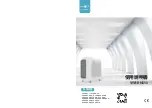
30
180
200
220
240
260
280
300
320
340
360
380
400
420
440
460
480
500
520
540
560
580
50 55 60 65 70 75 80 85 90 95 100 105 110 115 120 125 130 135
Li
qui
d
Pr
es
sur
e
(ps
ig)
Liquid Temperature (F)
Charging Chart - Cooling Operation - 6T P6 Units
Add refrigerant when below curve
Remove refrigerant when above curve
P6SP CHARGING CHARTS, COOLING ONLY
This equipments cooling systems contain refrigerant under
high pressure, always use safe practices when servicing
the unit. Always review the factory literature and safety
warnings prior to servicing.
All P6SP-072/090/120 units are shipped from the factory
with the proper amount and type of refrigerant. Always
inspect the unit rating label to determine the units
information prior to working on the system. Do not mix
different refrigerants or charge the unit with a refrigerant
not listed on the unit rating label.
The charging charts below are valid for a variety of indoor,
return air conditions and are most highly influenced by
the outdoor ambient temperature, outdoor fan operation
and the unit operating voltage. Before referencing the
charts below, always ensure that all compressor circuits
are energized and have stable operation. As can be seen
in the charging charts, the ideal system sub-cooling can
vary over the range of operation. Always reference the
charts to determine the ideal amount of sub-cooling for
a given liquid pressure. Units charged to other values will
not perform at the rated unit efficiency (EER).
To inspect a systems operation, using quality instruments,
APPLICATION NOTES ON THE USE OF CHARGING CHARTS
match the measured liquid temperature to the units chart.
The measured liquid pressure reading should be within
3% of the value shown for most installations. For two stage
systems, the charts are valid for both compressor stages.
DO NOT utilize the charts for two stage systems operating
only under a single stage call for cooling.
DO NOT utilize the charts in systems that do not have
all the outdoor fans energized, or have the fans cycling
under a low-ambient control. Refer to the low-ambient kit
instructions for more information, if applicable.
For systems that are operating with more then a 5%
deviation, inspect the unit for leaks. Always use safe and
environmentally sound methods for refrigerant handling.
When repairing system leakages, always utilize a nitrogen
(inert) gas to protect the refrigerant system and pressure
check the repair before re-charging. Always replace the
filter-dryers when performing any repair to the refrigeration
system. After completing the repairs, evacuate the system
to 350-500 microns and
weight in
the refrigerant to the
amount specified on the unit rating label.
Figure 15. Charging Chart for Single Stage Cooling Systems - 6 Ton units



































